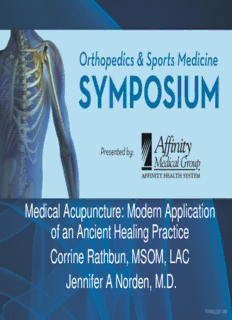
Medical Acupuncture: Modern Application of an Ancient Healing PDF
Preview Medical Acupuncture: Modern Application of an Ancient Healing
Medical Acupuncture: Modern Application of an Ancient Healing Practice Corrine Rathbun, MSOM, LAC Jennifer A Norden, M.D. Mary Kimball Anhaltzer Center for Integrative Medicine Affinity’s Integrative Medicine Program • Consults—Drs. Kimbrough and Norden Treatment plans include nutrition, physical activity, stress management, supplements • Acupuncture Drs. Kimbrough and Norden Corrine Rathbun, L.Ac. • Massage Therapy • Classes - mindfulness meditation, yoga, acupressure, aromatherapy • Locations - AMG-Koeller Street in Oshkosh and AMG- Greenville History of Acupuncture • Over 3000 years old originating in China • Part of Traditional Chinese Medicine • Introduced in Europe in the 1700’s and in USA in 1970’s • One of the oldest and most commonly used medical treatments used around the world Many Types of Acupuncture • Traditional Chinese Medicine • Japanese Style acupuncture • Anatomical Acupuncture – Based on Western knowledge of neuroanatomy • Acupuncture Microsystems – Korean Hand Acupuncture – Scalp Acupuncture – Auricular Acupuncture Acupuncture Microsystems • Auricular • Korean Hand Acupuncture Acupuncture How Does It Work? Traditional Chinese Medicine Theory • Qi - Chinese word representing the concept of energy • Qi circulates through the body through meridians • Over 1,000 acu-points - an area where Qi is easily found • Each point is very individual, can be categorized in many different ways and has it's own indications and contraindications. • Therapies applied to acu-points to restore the flow of Qi – acupuncture/acupressure, massage, moxa, etc. How Does It Work? Traditional Chinese Medicine Theory • Balances yin and yang – 2 opposing factors found in everything (water/fire, night/day, excess/deficiency, cold/hot, fixed/fluid) • Restores balance and harmony • Concepts of dampness, wind, fire, phlegm, etc. How Does It Work? Western Medicine Research • Acupuncture points on myofascial trigger points and near major nerves: vasodilation, muscle relaxation • Gate Control Theory: blocks pain • Needles stimulate nerves affecting CNS and regulating release of neurotransmitters: endorphins, serotonin, norepinephrine, dopamine, substance P • Neurotransmitter release: influences immune system, balances ANS and reduces pain • Stimulates hypothalamus and pituitary gland Acupuncture v. Dry Needling Acupuncture Dry Needling •Mind/body/spirit considered in •Treats specific condition – decreases treatment plans along with specific inflammation, improves ROM, decreases condition pain •Can treat internal complaints and •Needles placed at local area musculoskeletal complaints •Needles not retained •Needles placed throughout body, along •Often deeper needle depth meridians •Manual stimulation •Needle depth varies for each patient and condition •Needles retained for 10 – 30 minutes •Possible manual manipulation •Possible electrical stimulation
Description: